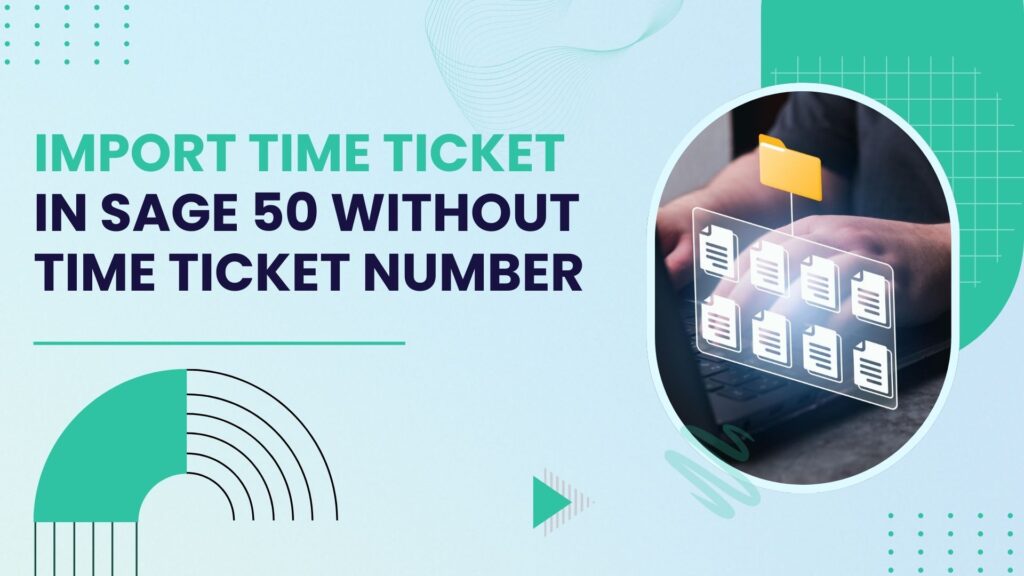Sage 50 is a widely used accounting software solution designed to streamline financial management for small and medium-sized businesses. Its robust features allow users to manage invoices, track sales, and oversee supplier transactions effectively. One of the key functionalities of Sage 50 is the ability to import invoices directly into the system, which can save significant time and effort for businesses managing high volumes of transactions. This article provides a detailed guide on how to import invoices into Sage 50, including sales invoices, purchase invoices, and supplier invoices.
Why Import Invoices into Sage 50?
Before diving into the process, it’s important to understand the benefits of importing invoices into Sage 50. Here are some of the key reasons why this feature is valuable:
- Efficiency: Manual data entry can be time-consuming and prone to errors. Importing invoices allows businesses to process large volumes of data quickly and accurately.
- Data Consistency: Importing invoices from external systems ensures consistency across platforms, reducing discrepancies between records.
- Integration with Other Systems: Many businesses use external systems, such as CRM tools or e-commerce platforms, to manage transactions. Sage 50’s import functionality allows seamless integration between these systems.
- Compliance: Accurate invoicing is crucial for tax compliance and financial reporting. Importing ensures the data is correctly structured and ready for audits.
- Scalability: As businesses grow, the number of transactions increases. Importing invoices into Sage 50 helps manage this growth effectively without overloading staff.
Preparing to Import Invoices into Sage 50
Understanding Sage 50’s Import Format
To import invoices successfully, you need to follow Sage 50’s predefined format. Sage 50 typically requires data in CSV (Comma-Separated Values) or TXT file formats. Each column in the file corresponds to specific fields in Sage 50, such as:
- Invoice Number
- Customer or Supplier Code
- Invoice Date
- Line Item Description
- Quantity
- Unit Price
- Tax Code
- Total Amount
The exact format can vary depending on the version of Sage 50 you are using, so it’s important to refer to Sage 50’s documentation for details.
Setting Up Customers and Suppliers
Before importing invoices, ensure that all customers and suppliers referenced in the invoices exist in Sage 50. If not, create the necessary records in the system. This ensures that Sage 50 can match the imported data to the correct accounts.
Validating Data
Ensure that the data in your CSV or TXT file is accurate and complete. Common issues to watch out for include:
- Missing fields
- Incorrect formatting (e.g., date formats, decimal separators)
- Duplicate records
Using a spreadsheet program like Microsoft Excel or Google Sheets can help you clean and organize your data before importing.
Also Read: How to migrate Sage 50 to Cloud hosting?
How to Import Sales Invoices into Sage 50?
1. Prepare the Sales Invoice File
- Open your spreadsheet program and create a new file.
- Add columns for each required field, such as:
- Invoice Number
- Customer Code
- Invoice Date
- Item Description
- Quantity
- Unit Price
- Tax Code
- Total Amount
- Populate the file with sales invoice data.
- Save the file in CSV format.
2. Access the Import Feature
- Open Sage 50 and log in with administrator privileges.
- Navigate to File > Import/Export.
- Select Import Records and choose the Sales Invoices option.
3. Map the Fields
- Sage 50 will prompt you to map the fields in your file to the corresponding fields in the software.
- Use the dropdown menus to match each column in your CSV file to the appropriate Sage 50 field.
- Save the mapping for future use if you plan to import invoices regularly.
4. Validate and Import
- Preview the data to ensure everything is mapped correctly.
- Click Import to process the file.
- Review the import log for any errors or warnings. Correct any issues and re-import if necessary.
Best Practices for Importing Sales Invoices
- Include a unique invoice number for each record to avoid duplication.
- Verify that the tax codes in your file match the codes set up in Sage 50.
- Use batch imports for high-volume transactions to save time.
How to Import Purchase Invoices into Sage 50?
1. Prepare the Purchase Invoice File
- Open your spreadsheet program and create a new file.
- Add columns for each required field, such as:
- Invoice Number
- Supplier Code
- Invoice Date
- Item Description
- Quantity
- Unit Price
- Tax Code
- Total Amount
- Populate the file with purchase invoice data.
- Save the file in CSV format.
2. Access the Import Feature
- Open Sage 50 and log in with administrator privileges.
- Navigate to File > Import/Export.
- Select Import Records and choose the Purchase Invoices option.
3. Map the Fields
- Map the fields in your file to the corresponding fields in Sage 50.
- Save the mapping configuration for future imports.
4. Validate and Import
- Preview the data to ensure it is accurate.
- Click Import to process the file.
- Review the import log for any errors or warnings and address them as needed.
Best Practices for Importing Purchase Invoices
- Ensure all suppliers in your file exist in Sage 50.
- Double-check the tax codes and ensure they align with your tax setup.
- Include detailed descriptions for each line item to improve record-keeping.
How to Import Supplier Invoices into Sage 50?
The process for importing supplier invoices is similar to that of purchase invoices, as supplier invoices typically fall under the category of purchases. However, there are specific considerations to keep in mind:
Key Differences Between Purchase and Supplier Invoices
- Supplier Codes: Ensure that the supplier codes in your file match the codes in Sage 50.
- Supplier Account Details: Sage 50 links supplier invoices to their corresponding accounts, so accurate coding is critical.
Steps to Import Supplier Invoices
- Prepare the CSV file with fields such as:
- Invoice Number
- Supplier Code
- Invoice Date
- Item Description
- Quantity
- Unit Price
- Tax Code
- Total Amount
- Follow the same process outlined for purchase invoices, ensuring the mapping and validation steps are performed carefully.
Best Practices for Supplier Invoices
- Use consistent naming conventions for supplier codes.
- Verify payment terms and due dates in the imported data.
- Regularly reconcile supplier accounts to ensure accuracy.
Save time by seamlessly importing invoices into Sage 50. Need help? Our expert Sage 50 Support Team is ready at +1-888-820-7278 to assist you every step of the way.
Troubleshooting Common Issues
1. File Format Errors
Issue: Sage 50 rejects the file due to formatting issues.
Solution: Double-check that the file is saved in CSV or TXT format and that all required fields are included.
2. Data Mapping Errors
Issue: Fields in the imported file do not align with Sage 50 fields.
Solution: Review the field mapping step and ensure each column is correctly assigned.
3. Missing or Incorrect Records
Issue: Some invoices fail to import.
Solution: Check the import log for details on the errors. Common issues include missing customer or supplier codes and invalid dates.
4. Duplicate Records
Issue: Duplicate invoices appear after importing.
Solution: Ensure that the invoice numbers in your file are unique. Sage 50 may also have settings to prevent duplicates, so verify these in the system.
Advanced Tips for Importing Invoices into Sage 50
1. Automating the Import Process
Many businesses use third-party tools or scripts to automate the preparation and import of invoices into Sage 50. These tools can:
- Extract data from external systems (e.g., e-commerce platforms, ERP systems).
- Format the data automatically to match Sage 50’s requirements.
- Schedule regular imports to keep records up to date.
2. Using Sage 50 Add-Ons
Sage 50 offers various add-ons and integrations that can enhance the import process. For example:
- Excel Integration: Allows direct uploads from Excel files.
- Data Import Wizards: Simplify the mapping and validation process.
- API Access: For businesses with technical expertise, Sage 50’s API can be used to build custom import solutions.
3. Regular Data Audits
Conduct regular audits of your imported data to ensure accuracy and consistency. This includes:
- Comparing imported invoices against source records.
- Reconciling accounts to identify discrepancies.
- Reviewing tax calculations and ensuring compliance with local regulations.
Conclusion
Importing invoices into Sage 50 is a powerful feature that can save time, reduce errors, and improve financial management for businesses. Whether you’re importing sales invoices, purchase invoices, or supplier invoices, following the steps and best practices outlined in this guide will ensure a smooth and efficient process. By investing the time to set up accurate templates and workflows, you can leverage Sage 50 to its full potential and focus on growing your business.
Frequently Asked Questions (FAQs)
Yes, Sage 50 allows users to import various types of invoices, including sales invoices, purchase invoices, and supplier invoices, using the Import function. However, the file format and structure must match Sage 50’s requirements.
Sage 50 typically supports CSV and Excel files for importing invoices. Ensure the data is properly formatted and includes all required fields, such as invoice date, customer/supplier name, invoice number, and amounts.
To prepare your data:
1. Create a CSV or Excel file.
2. Include column headers like Customer Name, Invoice Number, Date, Item Details, Quantity, Price, and Tax.
3. Match the field names and sequence with Sage 50’s import template to avoid errors.
To import sales invoices:
1. Open Sage 50 and navigate to File > Import/Export > Import Records.
2. Select “Sales Invoices” as the record type.
3. Browse and upload your prepared CSV/Excel file.
4. Map the fields correctly using Sage 50’s import wizard.
5. Confirm the import and check for any errors.
Yes, purchase invoices can be imported by following a similar process to sales invoices. Choose “Purchase Invoices” as the record type during the import process and ensure supplier details and item lines are correctly mapped.
Common errors include:
1. Missing Required Fields: Ensure all mandatory columns (e.g., invoice number, date) are filled.
2. Incorrect Data Formats: Dates must follow the correct format (e.g., MM/DD/YYYY).
3. Unmapped Fields: Verify that all fields in your file are mapped to corresponding Sage 50 fields.
Once imported, invoices can be edited directly in Sage 50. Navigate to the invoice in the relevant module (e.g., Sales or Purchases) to make changes.
If your import fails:
1. Review the error report generated by Sage 50.
2. Check your file for missing or incorrect data.
3. Correct the issues and reattempt the import.
Yes, with third-party tools or custom scripts, you can automate the import of invoices into Sage 50. This is especially useful for businesses with frequent or high-volume invoice imports.
If your file includes duplicate invoice numbers, Sage 50 will flag this as an error and may prevent the import. Always check for duplicates before importing.




